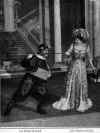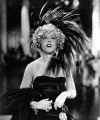The Merry Widow101
History of a Hit: Part III
by John Kenrick
Copyright 2004
(The images below are thumbnails – click on them to see larger versions.)
More Revivals
- New York City Opera staged several productions from the 1950s through the 1990s, most memorably a lavish 1977 version starring Beverly Sills and Alan Titus. Using a brilliant new translation by Broadway lyricist Sheldon Harnick, this Tito Capobianco production was lavish and gloriously entertaining.
- The Light Opera of Manhattan staged an intimate but equally effective version Off-Broadway in the 1970s which remained in their repertory until the company's demise in the 1980s. Alice Hammerstein Mathias (Oscar Hammerstein II's daughter) provided a witty translation, and French native Jeanne Bouvais was the first of many to play the title role.
- An Australian Opera production starred Joan Sutherland. For some years, it was the only English version available in home video formats.
- A long overdue Metropolitan Opera production in 2000 proved to be a disappointment despite the presence of operatic superstars Frederica Von Stade and Placido Domingo in the leads. A feeble translation and the Met's cavernous 3,000 seat house drained most of the requisite humor and charm from the material.
- PBS broadcast a lavish staging by the San Francisco Opera on Christmas night, 2002. Although pleasing to the eye, it suffered from terminal stuffiness and widespread miscasting.
New productions of The Merry Widow continue to appear. Although she has become a resident of the operatic stage, it would be a pity if Hannah (or Sonia, etc.) should ever drown in a sea of serious intentions. This Widow is, at heart, a creature of the popular stage, and and an embodiment of romantic comedy. One hopes future presentations retain the true lighthearted spirit that made Die Lustige Witew one of the 20th Century's brightest and most resilient cultural gems.
Sequels & Spoofs
 Lew Fields and Lulu Glasser
in Broadway's successful Merry Widow Burlesque.
Lew Fields and Lulu Glasser
in Broadway's successful Merry Widow Burlesque.
Lehar, Stein and Leon never expressed interest in writing a sequel to Die Lustige Witwe. However, several unauthorized follow-ups appeared in Vienna, including Die Lustige Witwe in Zweite Ehe (1907) -- ie: The Merry Widow's Second Marriage. It was initially well received, but without the melodic and comic flair provided by the original team, it soon faded into obscurity. That same year, Lehar composed Mitislaw der moderne (1907), a one act piece that allowed Louis Truemann to make fun of his own performance as the original Danilo.
Beloved Broadway clown Joe Weber staged and co-starred in a Merry Widow Burlesque (1907). Realizing that one of Weber's popular spoofs would only add to the original's ticket sales, Lehar and the New York producers happily provided him with the original orchestrations and costume designs. With Lulu Glasser in the title role of "Fonia" -- later replaced by the popular comedienne Blanche Ring -- this burlesque version ran for several profitable months, giving a substantial boost to the real Widow's box office.
Widow-mania inspired an inevitable backlash. A musical comedy entitled His Honor the Mayor (1906) won brief notoriety with the song, "I Wish I Could Find The Man Who Wrote The Merry Widow Waltz." But there was no denying that Americans could not get enough of The Merry Widow or its waltz. One New York variety house brazenly staged a competing musical adaptation of L'Attache d'ambassade -- using existing melodies that supposedly sounded like Lehar's. This substandard production did not last, and the genuine article waltzed on.
Film Versions
 Broadway
veteran Mae Murray starred in MGM's silent 1924 screen version of The
Merry Widow.
Broadway
veteran Mae Murray starred in MGM's silent 1924 screen version of The
Merry Widow.
Hollywood eventually filmed three versions of The Merry Widow -- all courtesy of Metro-Goldwyn-Mayer Studios.
The first was a silent film (1925), with a plot that winds up miles away from the original, concentrating on what happens before the original libretto. When showgirl Sally (after seemingly endless wooing) is abandoned at the altar by Prince Danilo, she marries aged Baron Sadoja, the richest man in Monteblanco -- who dies onscreen during the honeymoon. Danilo and Monteblanco's unsavory Crown Prince follow Sally to Paris, where she pretends to fall in love with the Crown Prince to make Danilo jealous. The resulting duel leaves Danilo wounded, but makes him new heir to his country's throne! He marries Sally, and they return to Monteblanco as King & Queen. Former stage star Mae Murray (as Sally) and screen idol John Gilbert (as Danilo) starred, and legendary martinet Erich Von Stroheim directed. Strange as all this may sound, Murray and Gilbert's on-screen waltz proved a sensation, and audiences turned out in droves worldwide to hear Lehar's melodies pour out of movie theatre orchestras, organs and pianos.
Nine years later, when production chief Irving Thalberg set out to establish MGM as Hollywood's ultimate source for screen musicals, he gathered a stellar team to create the 1934 sound version -- Ernst Lubitsch directed, while Maurice Chevalier and Jeanette MacDonald pursued each other in glorious black and white. Edward Everett Horton (hilarious as a bumbling Ambassador Popoff) and Una Merkel (as Marsovia's man-hungry Queen) enhance the fun. Once again, the plot bears limited resemblance to the original, with many key characters (Camille, Valencienne, etc.) missing. Most of the score is gone too, but the few remaining melodies have delightful lyrics by no less than Broadway master Lorenz Hart. Above all, the "Lubitsch Touch" combines flirtatious humor and continental atmosphere, making this a tastefully sexy comic romp. A major box office hit, this remains the most entertaining big screen version of The Merry Widow.
Television and changing economics were pushing the old studio system into extinction when MGM offered a costly 1952 Technicolor remake. Although Lana Turner looked luscious in the title role, her few singing sequences had to be dubbed. As Danilo, Fernando Lamas provided sex appeal and a surprisingly strong singing voice. These two stars were supposedly having a torrid affair off-screen, but there is no visible evidence of it in this tepid film. Richard Haydn desperately tries to win laughs as a bumbling Ambassador Popoff, but the humorless screenplay gives him nothing to work with. Una Merkel is on hand again, annd inexplicably wasted as the Widow's bland companion. It is easy to see why this Merry Widow did poorly at the box office.
Some sources list a 1956 film version of The Merry Widow in Arabic -- El Armula el tarub, directed by Helmy Rafla. To date, I have been unable to view this rarity. It has also proven impossible for this American author to track down a full color 1962 Austrian screen version starring Karen Hubner and Peter Alexander. In the 1980s, plans were announced for a new screen adaptation co-starring Placido Domingo and Julie Andrews, but nothing came of this tantalizing idea.
Widow En Point
 Peter
Martins and Patricia McBride in the 1982 PBS ballet version.
Peter
Martins and Patricia McBride in the 1982 PBS ballet version.
There have been several ballet versions of The Merry Widow, using re-arrangements of Lehar's melodies. The first, choreographed by Ruth Page, debuted in England as Vilia in 1953. Revised and retitled The Merry Widow, it toured the US and came to Broadway in 1955 with prima ballerina Alicia Markova dancing the title role. It was revived periodically by major ballet companies. Patricia McBride and Peter Martins starred in a PBS version broadcast from Chicago in 1982.
Maurice Bejart's adaptation premiered in 1963 and has had limited exposure. John Lanchberry created yet another version for the Australian Ballet in 1975. That company brought the piece to both London and New York with Margot Fonteyn and Marilyn Jones alternating in the title role. A new plot twists had Valencienne finally running off with Camille, leaving Ambassador Popoff broken hearted.
On the Air
The Merry Widow has made several appearances on American television, mostly thanks to Public Television. There have been numerous European telecasts, most of which were unavailable to American viewers. Several notable TV productions:
- 1955 (NBC): NBC offered the only commercial TV production to date. Anne Jeffreys and John Conte sang the romantic leads, while Hollywood veteran Edward Everett Horton was once more on hand as Popoff. Critics were less than impressed.
- An extremely handsome 1968 British TV production featuring opera diva Mary Costa and Jeremey Brett as Danilo has been posted in its entirety on Youtube. It is hampered by Christopher Hassall's mediocre English translation.
- 1977 (PBS): This lavish San Diego Opera production of The Merry Widow was taped on its 1977 premiere night. Beverly Sills and Alan Titus were delicious in the lead roles, but opening night jitters (and insufficient rehearsal time) led everyone in the cast to make a hash of Sheldon Harnick's superb new translation. Sadly, this version has never been available on commercial home video.
- 1996 (PBS): New York City Opera telecast a physically sumptuous staging originally produced by New Jersey's Paper Mill Playhouse. The broadcast was delightful, with Jane Thorngren and Michael Hayes in top vocal and comic form, and Broadway favorite George S. Irving winning laughs as Popoff. The new English lyrics were occasionally clumsy, and too much unnessesary nonsense was added to the already complex plot.
- 2002 (PBS): San Diego Opera really goofed with this lavish but lifeless staging. Yvonne Kenny and Bo Skovhus headed a wildly uneven cast, and it is clear that neither the performers nor the director knew how to handle this material. Wendy Wasserstein's new libretto provided a few flashes of wit but little period charm.
- 2015 (PBS): New York's Metropolitan Opera Company presented an elaborate staging by Tony Award winner Susan Strohman that featured Renee Fleming in the title role, Nathan Gunn as Danilo and an outstanding performance by Broadway star Kelli O'Hara as Valencienne. Unfortunately, Fleming sounds vocally strained, and most of the comedy failed to go over in the 3,000 seat house.
